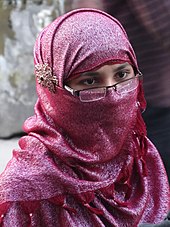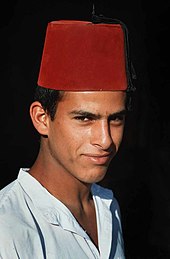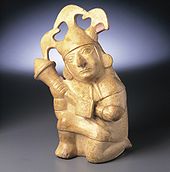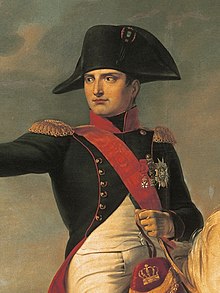Headgear
This article has multiple issues.Please helpimprove itor discuss these issues on thetalk page.(Learn how and when to remove these messages)
|


Headgear,headwear,orheaddressis any element ofclothingwhich is worn on one'shead,includinghats,helmets,turbansand many other types. Headgear is worn for many purposes, includingprotectionagainst the elements,decoration,or for religious or cultural reasons, includingsocial conventions.
Purposes
[edit]
Protection or defence
[edit]Headgear may be worn forprotectionagainst cold (such as the Canadiantuque), heat, rain and otherprecipitation,glare,sunburn,sunstroke,dust,contaminants, etc.Helmetsare worn for protection in battle or against impact, for instance when riding bicycles or motor vehicles.
Fashion
[edit]Headgear can be an article offashion,usuallyhats,capsorhoods.The formal man's black silktop hatwas formerly an indispensable portion of the suit, and women's hats have, over the years, attained a fantastic number of shapes ranging from immense confections to no more than a few bits of cloth and decorations piled on top of the head. Some hats, such asDeep Blue Sea,are showpiece creations created more as works of art than as practical items of fashion, and may be worth thousands or millions of dollars.

Religious significance
[edit]
Some headgear is worn for religious reasons.
InJudaism,men cover their heads out of reverence forGod.Jewish religious headgear for men include small cloth skull-caps, calledkippahsor yarmulkes. Some men wear them at all times, others only in thesynagogue.In Orthodox andHasidic Judaism,the kippah may also be additionally covered by hats such asfedorasorshtreimels.Traditional marriedJewishwomen cover their hair in various ways, such as with headscarfs, calledtichels,snoods,shpitzelsor wigs, called "sheitels", according to the principles andhalachaoftzniut.
Traditionally, Christian women are required to wear a headcovering as taught in1 Corinthians 11:2–16(the same text teaches that men are to pray and worship with their head uncovered), which has been practiced since the time of theearly Churchand continues to be observed universally in certain denominations, such as inConservative Anabaptistchurches.[1][2][3][4]The style of the headcovering varies by region, though the early Church'sApostolic Traditionspecifies thatChristian headcoveringis to be observed with an "opaque cloth, not with a veil of thin linen".[5]With respect toChristian clergy,thezucchettoworn byRoman Catholichierarchs is a skull-cap. Other forms of apostolic headgear include themitre,biretta,tasselled cardinal's hat, and thepapal tiara.Orthodox Christianclergy andmonasticsoften wear askufia,akamilavkion,or aklobuk.The termred hat,when used within theRoman Catholic Church,refers to the appointment of aCardinal,a senior "Prince of the Church", who is a member of theelectoral collegethat chooses thePope.On being appointed to the cardinalate, he is said to have received thered hat,or cardinal's biretta. In Lutheranism, many clergy wear theruffand in Anglicanism, theCanterbury capis popular among pastors.[6]
MaleSikhsare required to wearturbans.Some Sikh women also wear a turban; however it is not a requirement for female Sikhs. Turbans are also worn byMuslims,especiallyShia Muslims,who regard turban-wearing asSunnah Mu'akkadah(confirmed tradition).[7]
InIslam,thehijab,or headscarf, is worn by women because it is considered modest.[4]Muslim men also sometimes wear a skullcap called a "kufi"ortaqiyah (cap),especially during prayers. Headgear differs from culture to culture, and some Muslims' headgear is not related to their religion, such as the turbans worn in Saudi Arabia. Thedoppa,originating in theCaucasus,is worn byKazanTatars,UzbeksandUyghurs.Muslim men inIndonesiaandMalaysiaare often seen wearing akopiah,but its use pre-dates the arrival of Islam in the region.
The black satin headgear called or known as "fenta" or "topi" is a pillbox-shaped skullcap, worn byZoroastrians.It is considered by some in the Zoroastrian religion to be of vital spiritual importance. In earlier times, a saucer-shaped, red-and-white-striped kipah was the hallmark of the Zoroastrian.
Buddhistpriests inChinawear thebao-tzu(more commonly known as themao-tzu,MũMandarinmàozi), the classic skullcap that is the most like the Jewish tradition. InJapan,the cap is more in the form of a pillbox and is called theboshi( mũ ). Though not of ecclesiastical significance, the Buddhist skullcap does denote something about the priest's standing in the community.

Symbol of status or office
[edit]Headgear such as crowns and tiaras are worn in recognition of noble status especially among royalty. Wigs are worn traditionally by judges and barristers of Commonwealth nations.[citation needed]Feathered headpieces, such as thewar bonnetofPlains Indiancultures, are worn by various Native North American and South Americanindigenous peoples.[8]
Other uses
[edit]Other purposes of headgear include:
- keeping hair contained or tidy (including scrunchies, ball caps, etc.)
- medical purposes, such asorthodontic headgear
- modestyorsocial convention
- sport uniform
- traditional ceremonies
Types
[edit]Bonnets
[edit]
Bonnets,as worn by women and girls, were hats worn outdoors which were secured by tying under the chin, and often which had some kind of peak or visor. Some styles of bonnets had peaks so large that they effectively prevented women from looking right or left without turning their heads. Bonnets worn by men and boys are generally distinguished from hats by being soft and having no brim—this usage is now rare (they would normally be called caps today, except inScotlandwhere the "bunnet" is common in both civilian life and in theRoyal Regiment of Scotland).
Caps
[edit]Capsare generally soft and often have no brim or just a peak (like on a baseball cap). For many centuries women wore a variety of head-coverings which were called caps. For example, in the 18th and 19th centuries a cap was a kind of head covering made of a flimsy fabric such asmuslin;it was worn indoors or under a bonnet by married women, or older unmarried women who were "on the shelf" (e.g.mob-cap). Anochipokis part of traditionalUkrainiancostume.
Crowns
[edit]Some headgear, such as thecrown,coronet,andtiara,have evolved into jewelry. These headgear are worn as a symbol of nobility or royal status.Kokoshnikis part ofRussiantraditional dress, often worn by nobility.
Fillets
[edit]Afilletorcircletis a round band worn around the head and over the hair. Elaborate and costly versions of these eventually evolved intocrowns,but fillets could be made from woven bands offabric,leather,beadsormetal.Fillets are unisex, and are especially prevalent in archaic toRenaissancedress.
Hair covers
[edit]Hairnetsare used to prevent loose hair from contaminating food or work areas. Asnoodis a net or fabric bag pinned or tied on at the back of a woman's head for holding the hair.Scarvesare used to protect styled hair or keep it tidy. Shower caps andswim capsprevent hair from becoming wet or entangled during activity.
Hats
[edit]
Hatsoften have a brim all the way around the rim, and may be either placed on the head, or secured with hat-pins (which are pushed through the hat and the hair). Depending on the type of hat, they may be properly worn by men, by women or by both sexes.
Helmets
[edit]Helmetsare designed to protect the head, and sometimes the neck, from injury. They are usually rigid, and offer protection from blows. Helmets are commonly worn inbattle,on construction sites and in manycontact sports(most commonly being associated withAmerican football). In most of the United States they are required by law for anyone operating a range of vehicles including motorcycles, and sometimes extending to bicycles and skateboards.
Hoods
[edit]
Modernhoodsare generally soft headcoverings which are an integral part of a larger garment, like anovercoat,shirtorcloak.
Historically,hoodswere either similar to modern hoods, or a separate form of headgear. In medievalEuropehoods with short capes, calledchaperonsin French, were extremely common, and later evolved into elaborate and adaptable hats. Women's hoods varied from close-fitting, soft headgear to stiffened, structured hoods (e.g.gable hoods,henninsorFrench hoods) or very large coverings made of material over a frame which fashionable women wore over towering wigs or hairstyles to protect them from the elements (e.g. calash).
Masks
[edit]Amaskis worn over part or all of the face, frequently to disguise the wearer, but sometimes to protect the face. Masks are often worn for pleasure to disguise the wearer atfancy dressparties, masked balls, duringHalloweenor other festivals, or as part of an artistic performance. They may also be worn by criminals to prevent recognition or as camouflage while they commit a crime. Masks which physically protect the wearer vary in design, from guard bars across the face in the case of ice hockey goalkeepers, to facial enclosures which purify or control the wearer's air supply, as ingas masks.
Orthodontic headgear
[edit]
Orthodontic headgear is used to control the growth of themaxillaryandmandibularbones duringorthodontictreatment. The most common treatment headgear is used to correct anteroposterior discrepancies. The headgear attaches to the braces via metal hooks or a facebow. Straps or a head cap anchor the headgear to the back of the head or neck. In some situations, both are used.[9]
Elastic bands are used to apply pressure to the bow or hooks which is then transferred to the patients teeth and jaw. Its purpose is to slow or stop the upper jaw from growing, thereby preventing or correcting an overjet. Other forms of headgear treat reverse overjets, in which the top jaw is not forward enough.[medical citation needed]
Turbans
[edit]
Turbansare headgear, mostly for males, made up from a single piece of cloth which is wrapped around the head in a wide variety of styles. Turban is the best known word in English for a large category of headgear and general head wraps traditionally worn in many parts of the world. All over the worldSikhswear a turban as religious headgear.
Turbans for women are a popular choice during chemotherapy treatment as an alternative to wigs, hats, headscarves and headbands. Sikh women also wear turbans as a religious practice. Turbans for women made in natural fabrics are both comfortable and functional. The Breast Cancer Care booklet,Breast Cancer and Hair Loss,suggests: "You may want to wear a soft hat or turban in bed to collect loose hairs."[10][11]
Veils and head wraps
[edit]
Aveilis a piece of sheer fabric that covers all or part of the face. For centuries women covered their hair, neck, ears, chin, and parts of the face with fabric. Each culture created elaborate head wraps for women and men using ashawl,headscarf,kerchiefor veil. Very elaborate veiling practices are common inIslam,AfricaandEastern Europe.Women who do not cover their head on a regular basis, often use a veil in traditionalweddingandfuneralceremonies.
Wigs
[edit]Wigsare headpieces made from natural or synthetic hair[12]which may be worn to disguisebaldnessor thin hair, or as part of acostume.Atoupeemay be worn by a man to cover partial baldness. In mostCommonwealthnations, special wigs are also worn bybarristers,judges,and certainparliamentaryofficials as a symbol of the office.
Culture-specific types
[edit]-
BororoIndian men,Mato Grosso,Brazil
-
Tsimshian(Native American)Wooden Skull Headdress,late 19th century
Dhari
[edit]The dhari, also spelt dhoeri, is a distinctive headdress worn by men of theTorres Strait Islands,which lie in theTorres Straitbetween Australia andPapua New Guinea,for dance performances or cultural ceremonies. It is traditionally made with apearl shellorturtle shellin the middle and decorated with white feathers,[13]traditionally from thefrigate birdorTorres Strait pigeon,although now made with a variety of materials.[14]The head is often shaken to produce a shimmering effect while dancing.[15]Dhari,the word used in the eastern islands of the strait, is theMeriam Mirword for "headdress". In the central and western islands, it is known asdhoeri,in theKala Lagaw Yalanguage of those islands.[15]
The dhari is today a potent symbol forTorres Strait Islander people,and used in theTorres Strait Islander flag.[13][16]Torres Strait Islander artists such asAlick Tipoti[17]andKen Thaiday Snrcreate dhari as artworks.[18][19]
War bonnet
[edit]War bonnets,which usually include an array of feathers, are worn mostly by men in variousPlains Indiancultures in the United States. They are linked to status, culture and ceremony, and have to be given as gifts as a mark of respect for the receiver.[20]
Etiquette
[edit]This sectionneeds additional citations forverification.(December 2022) |
In theWesternculture derived fromChristiantradition, removing one's headgear is a sign of respect, especially indoors, making oneself more open, humble or vulnerable, much like bowing or kneeling. This is as if to say, "I acknowledge that you are more powerful than I am, I make myself vulnerable to show I pose no threat to you and respect you." Men's hats are removed in Church, and not removing them is usually frowned upon. Women, however, are required to wear a hat to cover the head in some churches based on1 Corinthians 11:5.

In theJewishtradition, the converse idea equally shows respect for the superior authority of God. Wearing akippahoryarmulkemeans the wearer is acknowledging the vast gulf of power, wisdom, and authority that separates God from mankind. It is a sign of humility to wear a yarmulke. There is a common[weasel words]phrase that explains this, saying that "there's always something above" one who is wearing a yarmulke, helping one remember one is human and God is infinite. A Talmudic quote speaks of a righteous man who would "not walk (six feet) with an uncovered head, the (spirit of God) is always above him". Jews also may wear a fur hat or a black hat with a brim.
InIslamicetiquette, wearing headgear, traditionally thetaqiyah (cap),is permissible while saying prayers at amosque.[21]

In themilitary,there are specific rules about when and where to wear a hat. Hats are generally worn outdoors only, at sea as well as on land; however, personnel carrying firearms typically also wear their hats indoors. Removing one's hat is also a form ofsalute.Manyschoolsalso have this rule due to the fact that many younger men tend to wear baseball caps and this being in relations togangsdepending on the side in which the hat is worn.
A hat can be raised (briefly removed and replaced, with either hand), or"tipped"(touched or tilted forward) as a greeting.
See also
[edit]- List of headgear
- List of hat styles
- Chapeaugraphy—an act in which a ring of felt is shaped to resemble many hat types
- Mathabana
References
[edit]- ^Bercot, David W. (1992).Common Sense: A New Approach to Understanding Scripture.Scroll Publishing Co. p. 68.ISBN978-0-924722-06-6.
Hippolytus, a leader in the church in Rome around the year 200, compiled a record of the various customs and practices in that church from the generations that preceded him. HisApostolic Traditioncontains this statement: "And let all the women have their heads covered with an opaque cloth, not with a veil of thin linen, for this is not a true covering." This written evidence of the course of performance of the early Christians is corroborated by the archaeological record. The pictures we have from the second and third centuries from the catacombs and other places depict Christian women praying with a cloth veil on their heads. So the historical record is crystal clear. It reveals that the early generation of believers understood the head covering to be a cloth veil—not long hair.
- ^"Veil".Early Christian Dictionary.Retrieved7 September2021.
- ^Earle, Alice Morse (1903).Two Centuries of Costume in America, Vol. 2 (1620–1820).The Macmillan Company. p. 582.
One singular thing may be noted in this history, – that with all the vagaries of fashion, woman has never violated the Biblical law that bade her cover her head. She has never gone to church services bareheaded.
- ^abHunt, Margaret (11 June 2014).Women in Eighteenth Century Europe.Taylor & Francis. p. 58.ISBN9781317883876.
Today many people associate rules about veiling and headscarves with the Muslim world, but in the eighteenth century they were common among Christians as well, in line with 1 Corinthians 11:4-13 which appears not only to prescribe headcoverings for any women who prays or goes to church, but explicitly to associate it with female subordination, which Islamic veiling traditions do not typically do. Many Christian women wore a head-covering all the time, and certainly when they went outside; those who did not would have been barred from church and likely harassed on the street.… Veils were, of course, required for Catholic nuns, and a veil that actually obscured the face was also a mark of elite status throughout most of Europe. Spanish noblewomen wore them well into the eighteenth century, and so did Venetian women, both elites and non-elites. Across Europe almost any woman who could afford them also wore them to travel.
- ^"On Head Coverings".Classical Christianity. 11 January 2012.Retrieved25 January2022.
And let all the women have their heads covered with an opaque cloth, not with a veil of thin linen, for this is not a true covering. (Apostolic Tradition Part II.18)
- ^Hurton, William (1851).A Voyage from Leith to Lapland: Or, Pictures of Scandinavia in 1850.R. Bentley. p. 59.
The clerk removed his mantle at the conclusion of this part of the service, and he then retired to robe himself in a black gown and high white ruff (the every-day costume of the Lutheran clergy), in which he subsequently delivered his sermon. He also read and chanted in this black gown during a portion of the service.
- ^Haddad, Sh. G. F."The turban tradition in Islam".Living Islam.Retrieved5 August2013.
- ^"Native American Headdresses: Facts for Kids".Retrieved27 August2013.
- ^Children and Orthodontics: Types of Braces, Retainers, Headgear. webmd /oral-health/guide/children-and-orthodontics WebMD describes common types of orthodontics for children, including braces headgear, and retainers.
- ^"Breast cancer and hair loss (BCC54): Breast Cancer Care - Support and information for anyone affected by breast cancer".Archived from the original on November 25, 2009.Retrieved2011-05-06.
{{cite web}}:CS1 maint: bot: original URL status unknown (link) - ^Kanti Ghosh, Sumit (2023-05-18)."Body, Dress, and Symbolic Capital: Multifaceted Presentation of PUGREE in Colonial Governance of British India".Textile:1–32.doi:10.1080/14759756.2023.2208502.ISSN1475-9756.S2CID258804155.
- ^Georga, Yianna."Syntetic & Natural Wigs".website.YiannaGR.Retrieved17 September2013.
- ^ab"Headdress, Dari or Dhoeri, Meriam, Palm Island, East, Queensland, Australia, 1930s".Museums Victoria.Retrieved7 December2021.
- ^Marlow, Karina (29 September 2016)."10 things you may not know about the Torres Strait Islands".NITV.Retrieved7 December2021.
- ^ab"Dhari".Queensland Museum.Retrieved7 December2021.
- ^"Torres Strait Islander flag".Torres Strait Island Regional Council.Retrieved7 December2021.
- ^"Alick Tipoti".Australian War Memorial.Retrieved7 December2021.
- ^"Torres Strait land and sea dhari headdress".Cairns Art Gallery.Retrieved7 December2021.
- ^"'Green Dancing Dhoeri (Dhari)' by John Barsa ".Powerhouse Collection.Retrieved7 December2021.
- ^"Behind First Nations headdresses: What you should know".CBC News.27 March 2016.Retrieved7 December2021.
- ^Ebrahim, Mufti (2003-06-21)."Q & A: Wearing Cap While Praying".Albalagh.net.Retrieved2013-12-27.
External links
[edit]- The Head Covering MovementChristian head covering in the US
- Headgear Fashion Platesfrom The Metropolitan Museum of Art Libraries



